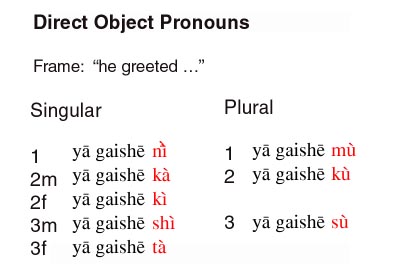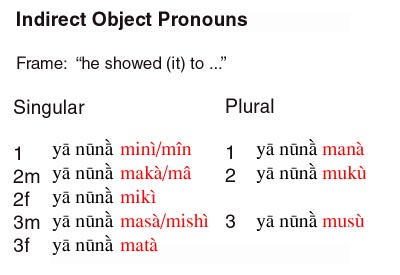Hausa pronouns

The main functions of the independent pronouns are as follows:
- Subject of predicate of a “ne/ce” sentence
-
Ni ne. ‘It’s me.’ Ita malama ce. ‘She is a teacher.’
- Object of a preposition
-
Mun zo da ita. ‘We came with her.’ Babu kowa sai kai. ‘There’s nobody except you.’
- Object of babu ‘there is no …’, ‘… do(es) not exist’
-
Q: Akwai “penguins” a Najeriya?
A: Babu su.Q: ‘Are there “penguins” in Nigeria?’
A: ‘There are none.’ – ‘They don’t exist.’
The main functions of the genitive or possessive pronouns are as follows:
- Indicate a pronoun possessor in genitive or possessive constructions
-
gidana ‘my house’ motarku ‘your car’
- Object of a verb which is in its nominal form, such as a “non-wa” verbal noun in the continuative
-
Suna zagina. ‘They are abusingme.’ Muna korarsu. ‘We are chasingthem.’

The main functions of the independent genitive or possessive pronouns are as follows:
- Indicate a pronoun possessor when the thing possessed is understood:
-
nawa
tawa‘mine’ (masculine possession understood)
‘mine’ (feminine possession understood)nata
tata‘hers’ (masculine possession understood)
‘hers’ (feminine possession understood)
- Expressing a pronoun possessor when the possessor precedes the possessed noun for emphasis:
-
nawa abokin
tawa k’awar‘MY (male) friend’
‘MY (female) friend’nata mijin
tasa matar‘HER husband’
‘HIS wife’
Hausa marks verb tenses with different sets of subject pronouns rather than marking changes in the verbs themselves. There are therefore separate sets of subject pronouns for all the Hausa verb tenses. Examples here illustrate the third person singular subject pronoun for each “tense”. Click the highlighted links to see the full pronoun paradigms.
| Completive | Sun sha shayi. | ‘They drank tea.’ |
| Relative Completive | Shayi suka sha. | ‘It tea that they drank.’ |
| Negative Completive | Ba su sha shayiba. | ‘They didn’t drink tea.’ |
| Continuative | Suna shan shayi. | ‘They are drinking tea.’ |
| Relative Continuative | Shayi suke sha. | ‘It is tea that they aredrinking.’ |
| Negative Continuative I | Ba sa shan shayi. | ‘They aren’t drinking tea.’ |
| Negative Continuative II | Ba su da mota. | ‘They don’t have a car.’ |
| Future | Za su sha shayi. | ‘They will drink tea.’ |
| Subjunctive | Su sha shayi. | ‘They should drink tea.’ |
| “Indefinite” Future | Sa sha shayi. | ‘They will surely drank tea.’ |
| Habitual | Sukan sha shayi. | ‘They drink tea.’ |

The main functions of the direct object pronouns are as follows:
- Indicate the direct object of a verb
-
Ya gaishe mu. ‘He greeted us.’ Zan taimake ki. ‘I will help you.’
- Indicate the object of akwai ‘there is … ‘, ‘… exists’
-
Q: Akwai macizai a Najeriya?
A: Akwai su.Q: ‘Are there snakes in Nigeria?’
A: ‘There are some. / Theyexist.’
- Indicate the object of ga ‘here … is’, ‘there … is’
-
Q: Ina Bala?
A: Ga shi can.Q: ‘Where is Bala?
A: There he is.’Q: Kuna ina?
A: Ga mu.Q: ‘Where are you?
A: ‘Here we are.’
- Indicate the object of the preposition gare ‘at the place of …, with …’
-
Hankali gareta. ‘Intelligence (is) with her,’ i.e. “She is smart.”
NOTE: Aside from a small class of exceptions, the tone of a direct object pronoun is opposite that of the syllable which precedes it:
Technical notes on -a and e- verbs with direct objects
(1) Direct object pronoun tones with verbs ending in -a and -e: Direct object pronouns nearly always have tone opposite to the preceding syllable. However, in two cases, pronoun objects copy a preceding High tone. Both involve “regular” verbs ending in -a or -e.
- Three syllable -a and -e verbs: In all tenses such verbs end in High tone and the pronoun object also takes High tone:
- -a and -e verbs in the Imperative: Such verbs (regardless of the number of syllables) end in High tone and the pronoun object also takes High tone:
(2) Final vowel length of -e verbs: Verbs ending in -e can keep a long final vowel before noun objects. If the vowel of a 3+ syllable verb is pronounced long, the final tone is also high.

The main function of the indirect object pronouns is to
- Indicate the indirect object of a verb
-
Ya nuna mini (gida). ‘He showed me (the house).’ Zan gaya miki (labari). ‘I will tell you (the news).’


